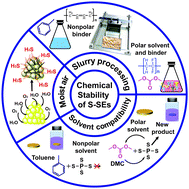Chemical stability of sulfide solid-state electrolytes: stability toward humid air and compatibility with solvents and binders
Abstract
Sulfide solid electrolyte (S-SE) based all-solid-state batteries (ASSBs) have received particular attention due to their outstanding ionic conductivity and higher energy density over conventional lithium-ion batteries. Nevertheless, their chemical instability toward air and their poor compatibility with solvents and binders are significant factors that impede the commercialization of S-SE-based ASSBs. This review aims to compile fundamental principles about the chemical stability of S-SEs and strategies designed to fabricate sulfide-based high energy density practical ASSBs covering their air stability and compatibility in slurry-based processes. Firstly, fundamental principles about the chemical stability of S-SEs towards air and their compatibility with solvents and binders are highlighted. Moreover, characterization techniques are examined to better understand the chemical stability of S-SEs. Secondly, the latest progress and effective strategies to improve the stability and compatibility of S-SEs are summarized. Encouraging demonstrations on improving the compatibility of S-SEs with solvents and binders are exemplified. Finally, challenges, future directions, and our perspectives on improving the chemical stability of S-SEs are presented.



 Please wait while we load your content...
Please wait while we load your content...